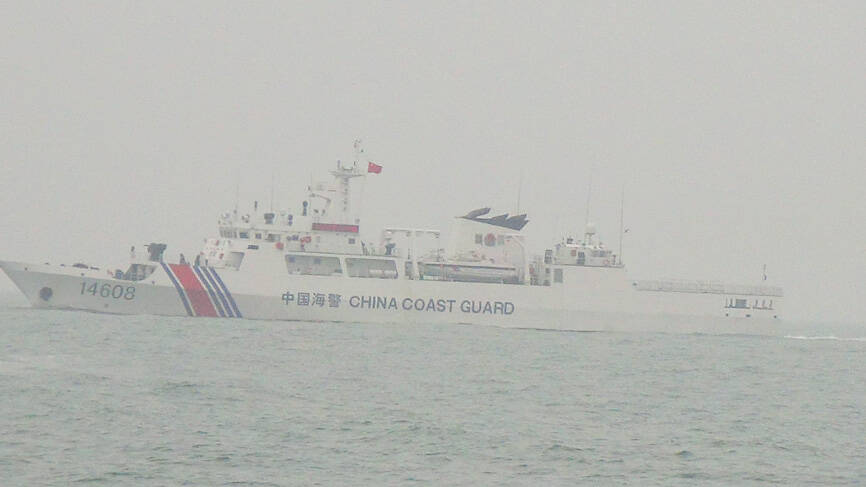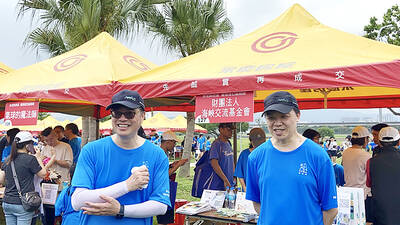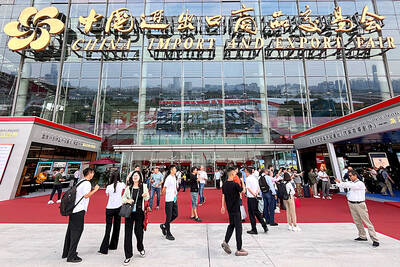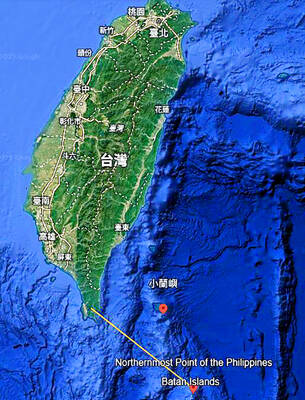Beijing’s continued provocations in the Taiwan Strait reveal its intention to unilaterally change the “status quo” in the area, the US Department of State said on Saturday, calling for a peaceful resolution to cross-strait issues.
The Coast Guard Administration (CGA) reported that four China Coast Guard patrol vessels entered restricted and prohibited waters near Kinmen County on Friday and again on Saturday.
A State Department spokesperson said that Washington was aware of the incidents, and urged all parties to exercise restraint and refrain from unilaterally changing the “status quo.”

Photo courtesy of the Coast Guard Administration
“Maintaining peace and stability across the Taiwan Strait is in line with our [the US’] consistent interests and is crucial to regional and global security and prosperity,” the spokesperson said in response to media queries.
China began regular coast guard patrols around Kinmen and Xiamen, China, following the deaths of two Chinese who fled from CGA personnel after their boat had entered prohibited waters near Kinmen on Feb. 14.
China’s Taiwan Affairs Office firmly supported the measure.
“Taiwan is part of China. The China Coast Guard’s patrols in the waters near Kinmen are a legitimate move to maintain the order of maritime operations,” it said.
In Taiwan, academics have called on the CGA to regularly deploy a larger vessel in waters near Kinmen in response to the China Coast Guard’s harassment.
After establishing “regular law enforcement” in waters near Kinmen, the China Coast Guard might turn its focus to the east of the Strait’s median line, National Policy Foundation associate research fellow Chieh Chung (揭仲) said on Saturday.
Taiwan should continue to maintain its authority in the Strait and waters near Kinmen, he said, adding that when encountering China Coast Guard vessels, CGA personnel should follow the necessary procedures without provoking conflict.
The “gray zone” tactics adopted by Beijing are troublesome, because it would be inappropriate to send the navy to intervene in incidents related to the China Coast Guard, as it is not the Chinese navy, Institute for National Defense and Security Research analyst Shu Hsiao-huang (舒孝煌) said.
Most of the CGA vessels deployed near Kinmen are small or medium-sized, and might not be able to deal with 8,000-tonne China Coast Guard vessels, he said.
He suggested renovating facilities in Kinmen for the development of one or two larger vessels.
Chieh agreed with the assessment, saying that most CGA vessels deployed in the area are about 100 tonnes.
It is easier for Chinese vessels to enter waters near Kinmen than to cross the median line of the Taiwan Strait as they are closer to China, he said.
As such, Taiwan should regularly deploy a large coast guard patrol vessel in the area, Chieh said, adding that if it does not have space to dock, it should be kept on standby near Kinmen as a deterrent.
The CGA could consider using the Ching Chiang (錦江艦) — a 700-tonne vessel that the navy is no longer using — if it is still functioning well, Shu said.
Chieh also called on the government to make public the movement of China Coast Guard vessels whenever appropriate.
The armed forces could provide intelligence to the government so that it could predict the course of Chinese vessels and dispatch personnel in advance, he said.
The air force’s E-2 Hawkeye all-weather early-warning aircraft would be of great help in providing information to the CGA, as it can view the Strait from eastern Taiwan, he added.

SECURITY: As China is ‘reshaping’ Hong Kong’s population, Taiwan must raise the eligibility threshold for applications from Hong Kongers, Chiu Chui-cheng said When Hong Kong and Macau citizens apply for residency in Taiwan, it would be under a new category that includes a “national security observation period,” Mainland Affairs Council (MAC) Minister Chiu Chui-cheng (邱垂正) said yesterday. President William Lai (賴清德) on March 13 announced 17 strategies to counter China’s aggression toward Taiwan, including incorporating national security considerations into the review process for residency applications from Hong Kong and Macau citizens. The situation in Hong Kong is constantly changing, Chiu said to media yesterday on the sidelines of the Taipei Technology Run hosted by the Taipei Neihu Technology Park Development Association. With

CARROT AND STICK: While unrelenting in its military threats, China attracted nearly 40,000 Taiwanese to over 400 business events last year Nearly 40,000 Taiwanese last year joined industry events in China, such as conferences and trade fairs, supported by the Chinese government, a study showed yesterday, as Beijing ramps up a charm offensive toward Taipei alongside military pressure. China has long taken a carrot-and-stick approach to Taiwan, threatening it with the prospect of military action while reaching out to those it believes are amenable to Beijing’s point of view. Taiwanese security officials are wary of what they see as Beijing’s influence campaigns to sway public opinion after Taipei and Beijing gradually resumed travel links halted by the COVID-19 pandemic, but the scale of

A US Marine Corps regiment equipped with Naval Strike Missiles (NSM) is set to participate in the upcoming Balikatan 25 exercise in the Luzon Strait, marking the system’s first-ever deployment in the Philippines. US and Philippine officials have separately confirmed that the Navy Marine Expeditionary Ship Interdiction System (NMESIS) — the mobile launch platform for the Naval Strike Missile — would take part in the joint exercise. The missiles are being deployed to “a strategic first island chain chokepoint” in the waters between Taiwan proper and the Philippines, US-based Naval News reported. “The Luzon Strait and Bashi Channel represent a critical access

Pope Francis is be laid to rest on Saturday after lying in state for three days in St Peter’s Basilica, where the faithful are expected to flock to pay their respects to history’s first Latin American pontiff. The cardinals met yesterday in the Vatican’s synod hall to chart the next steps before a conclave begins to choose Francis’ successor, as condolences poured in from around the world. According to current norms, the conclave must begin between May 5 and 10. The cardinals set the funeral for Saturday at 10am in St Peter’s Square, to be celebrated by the dean of the College